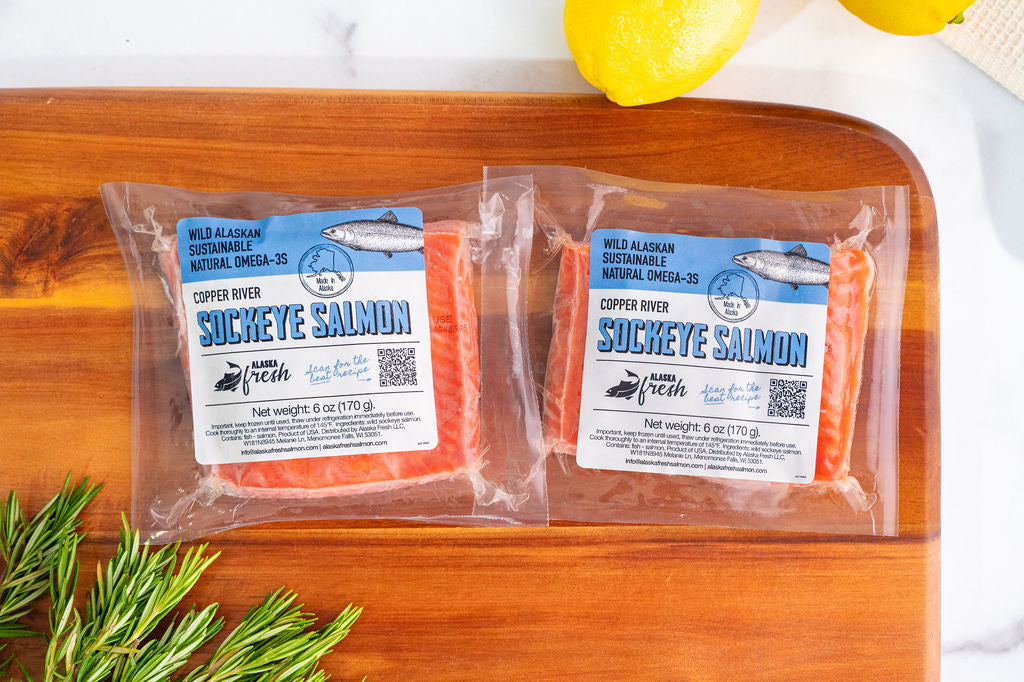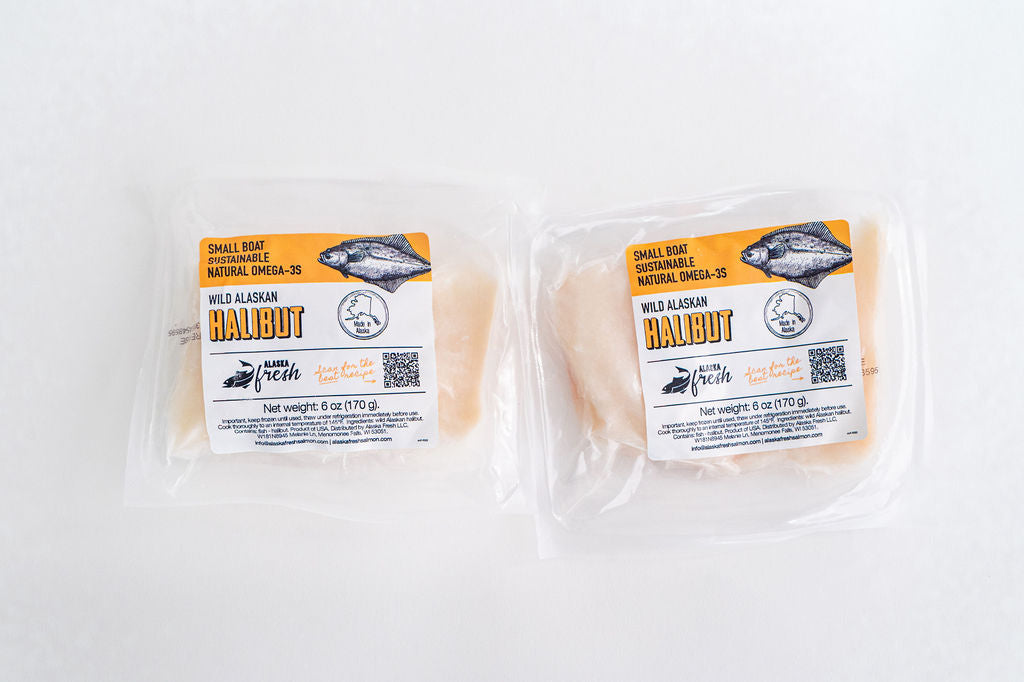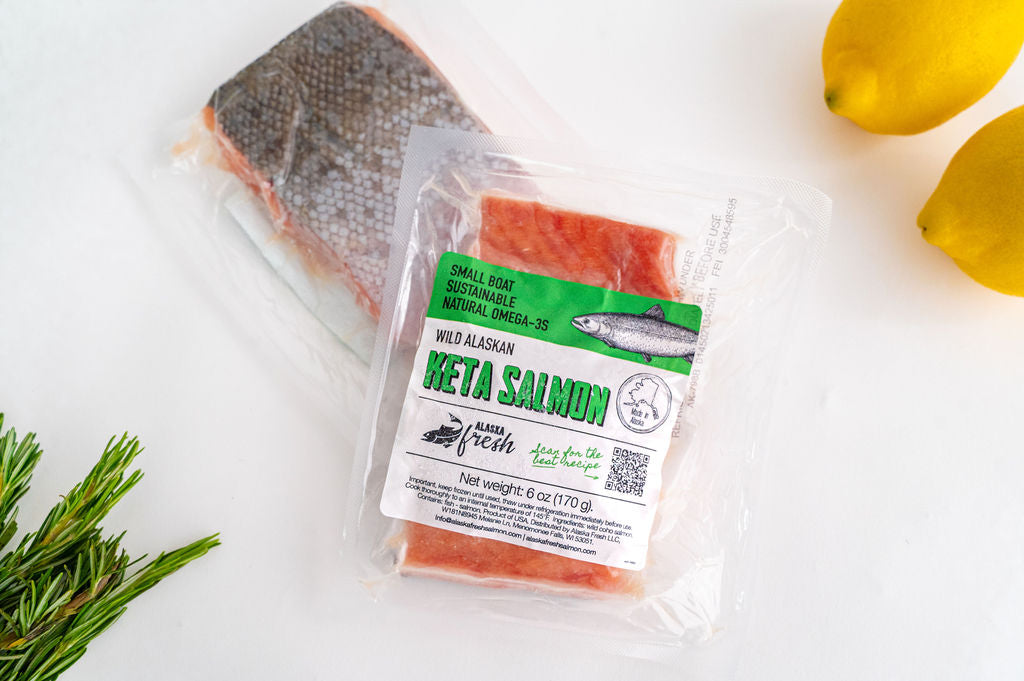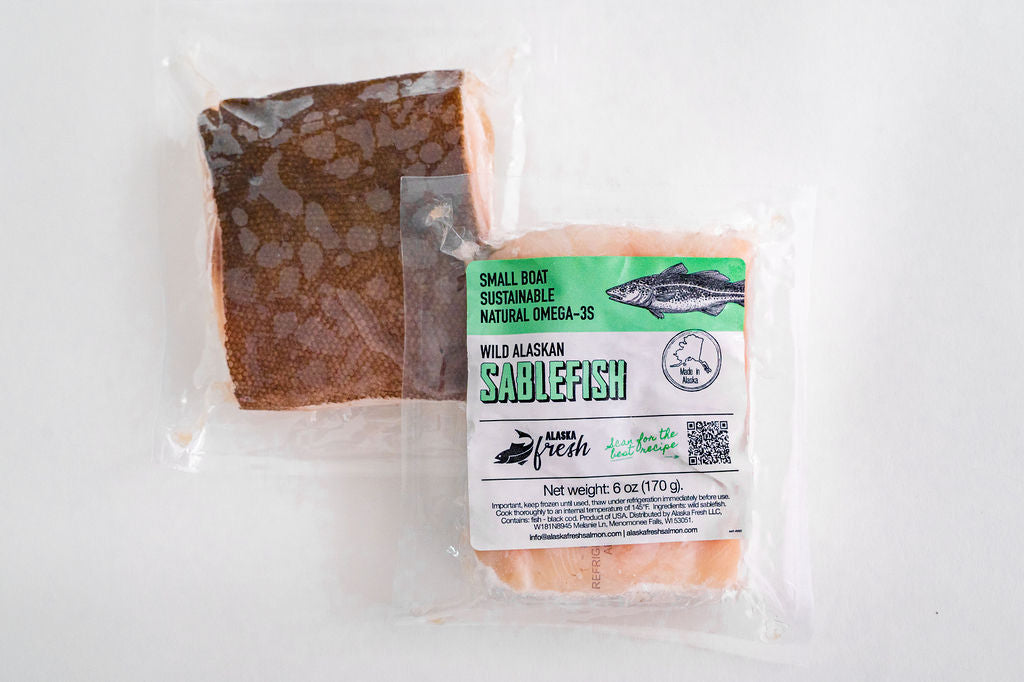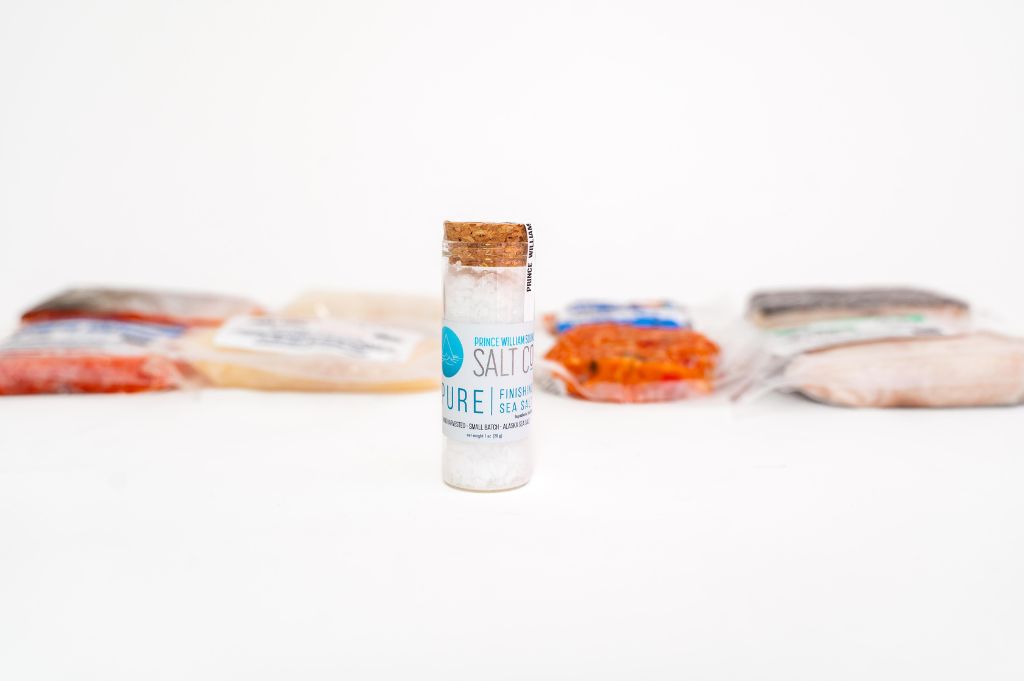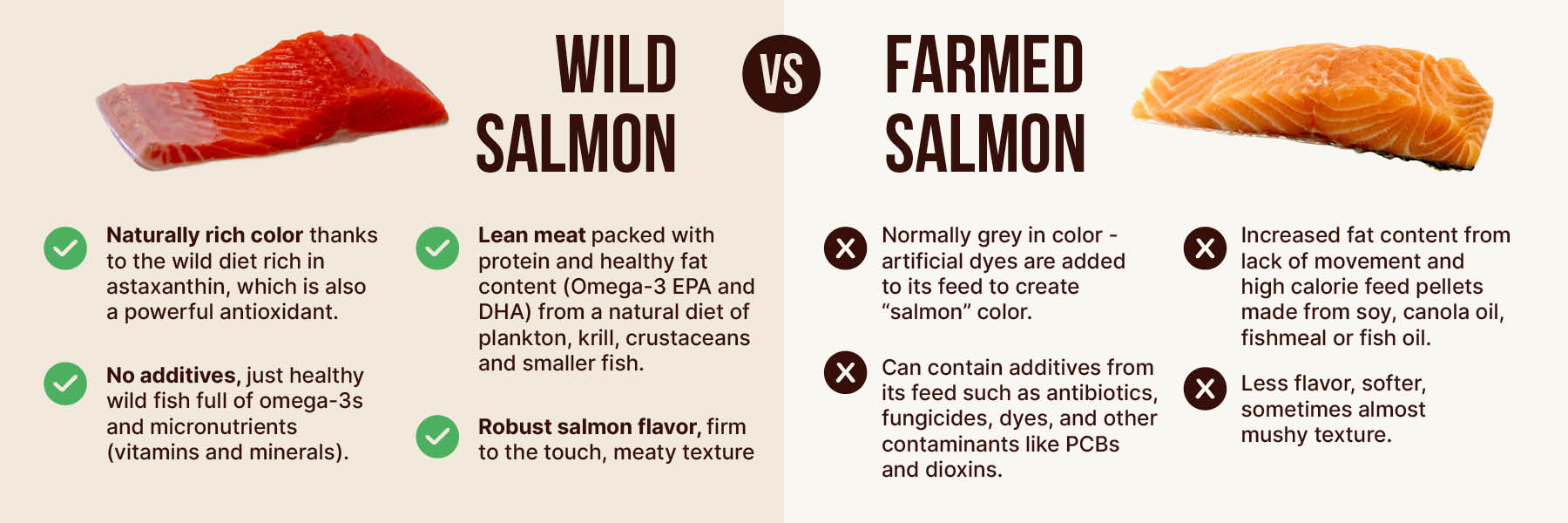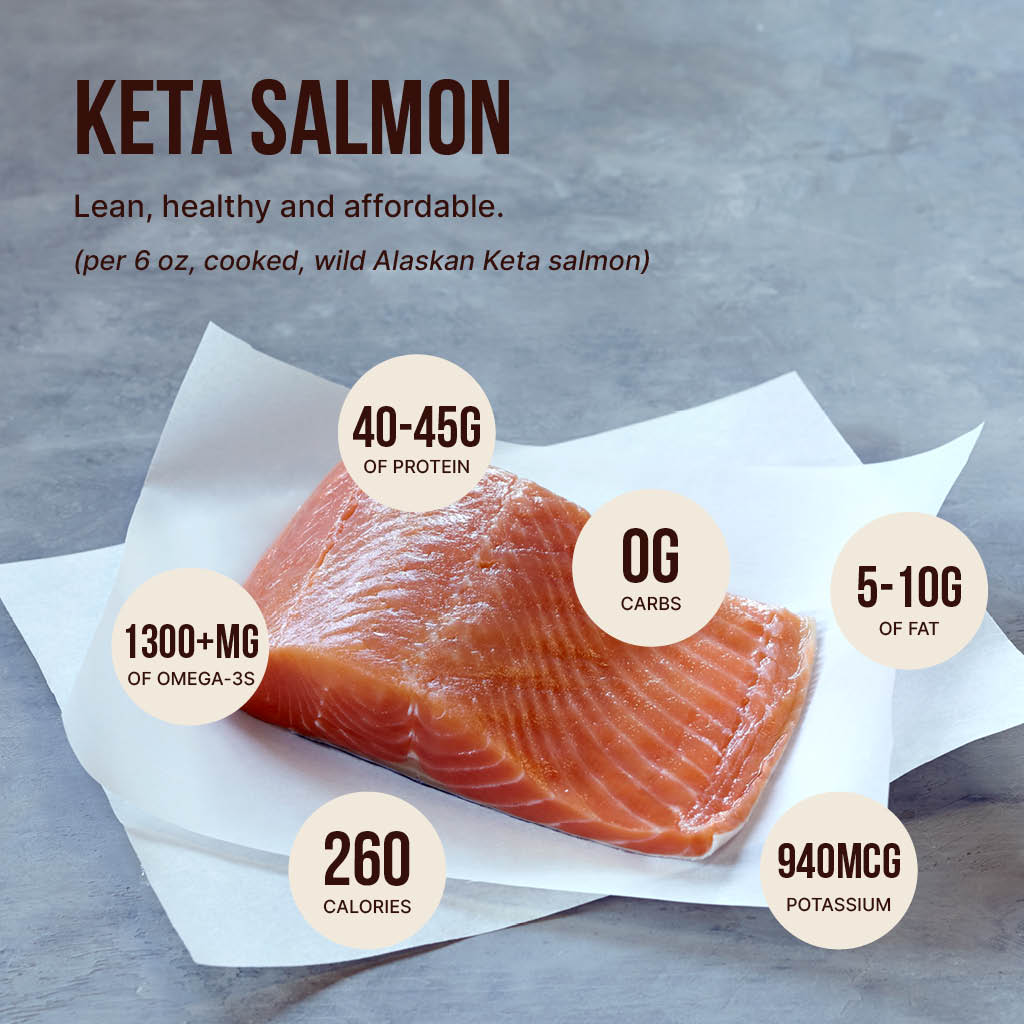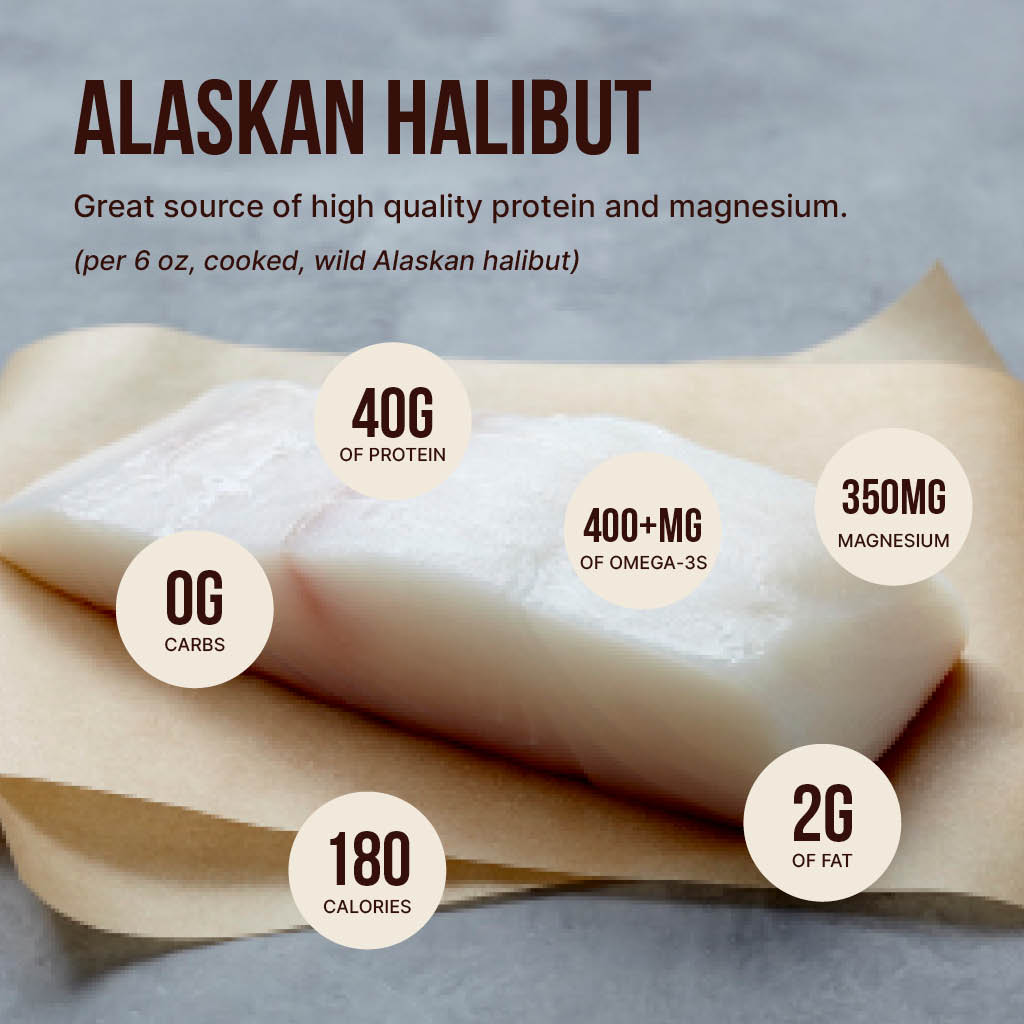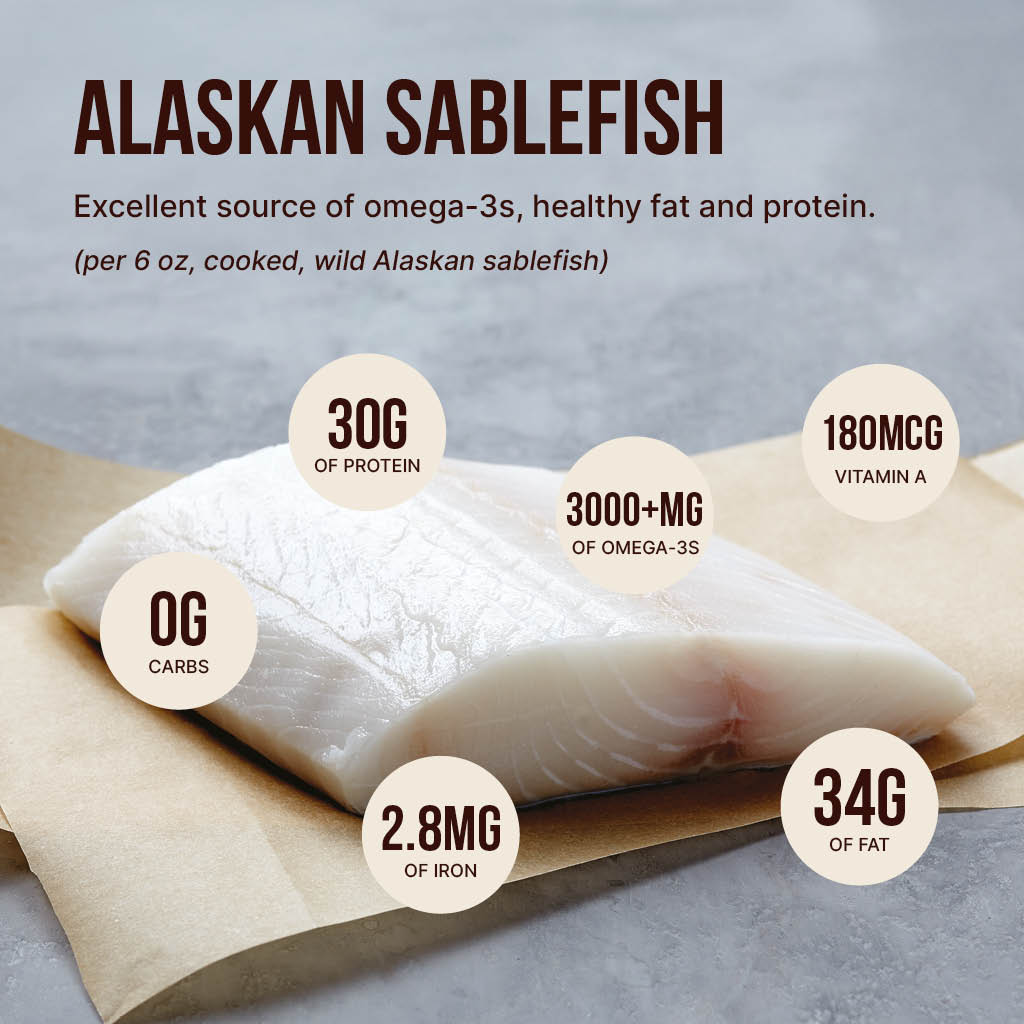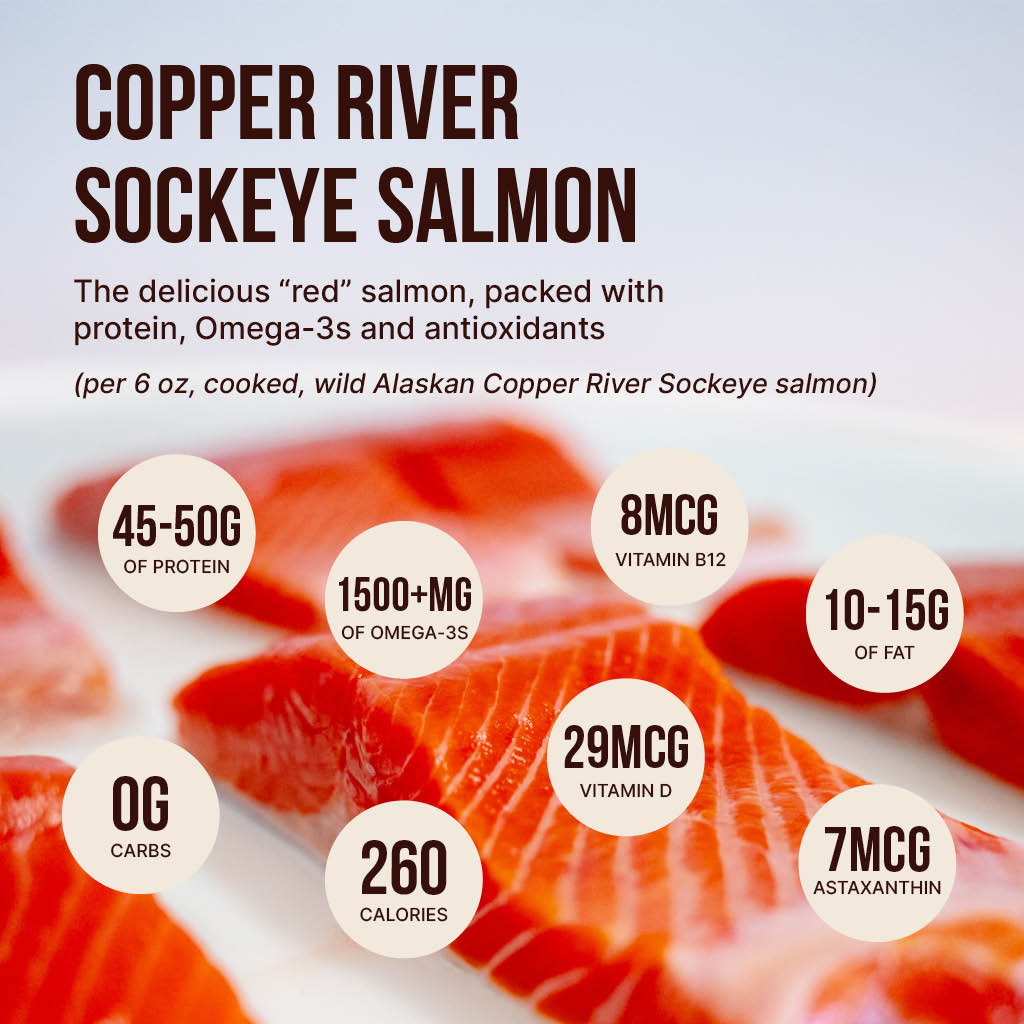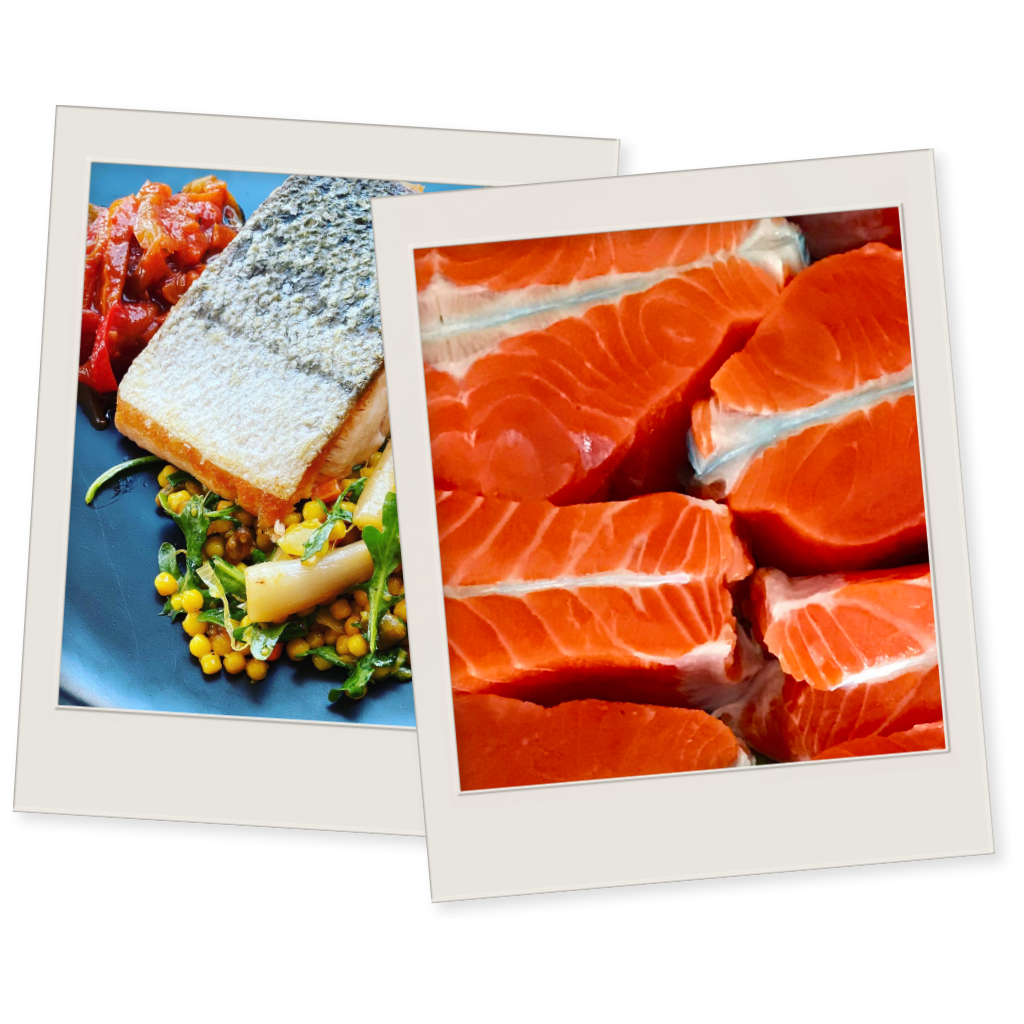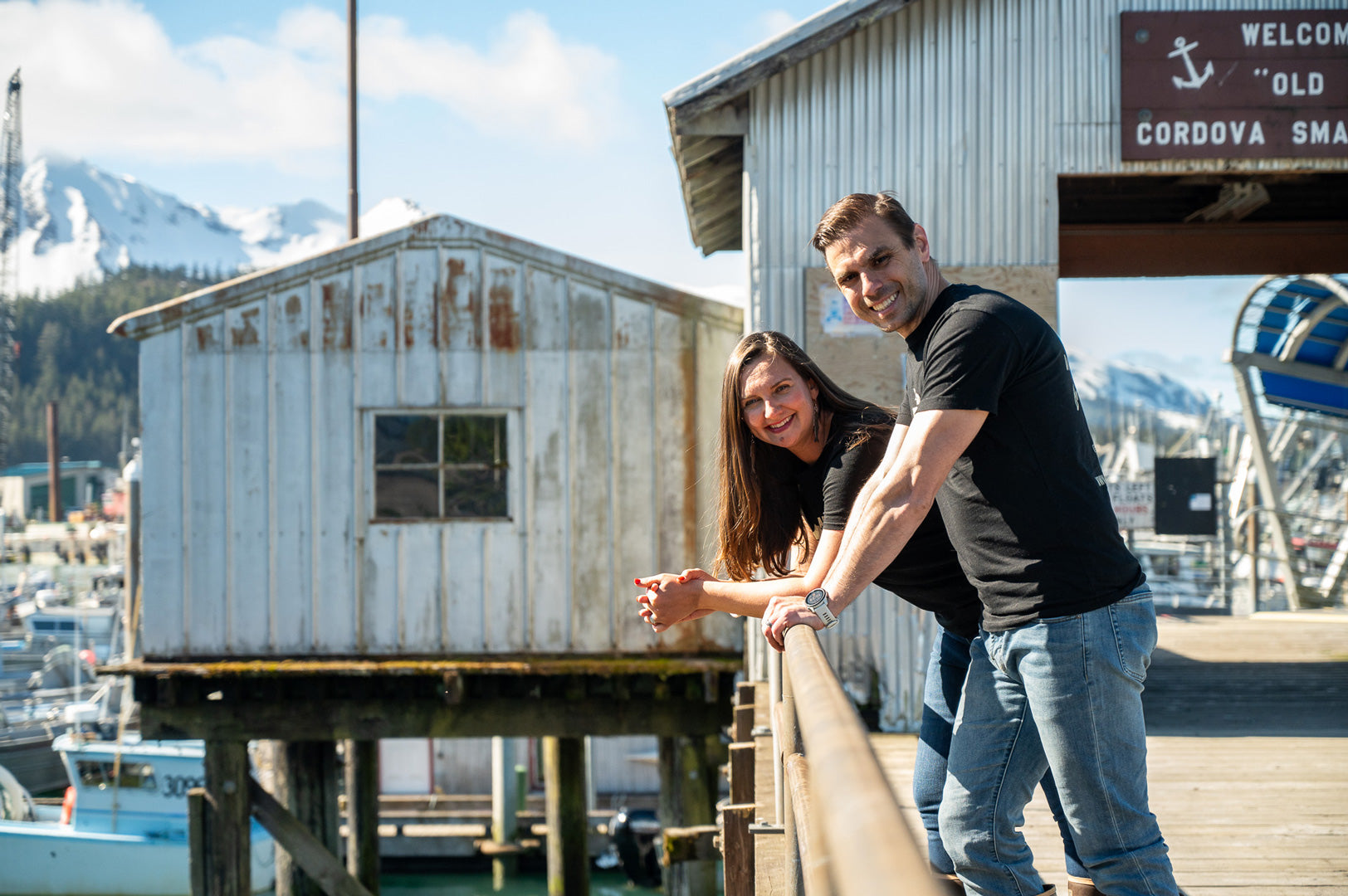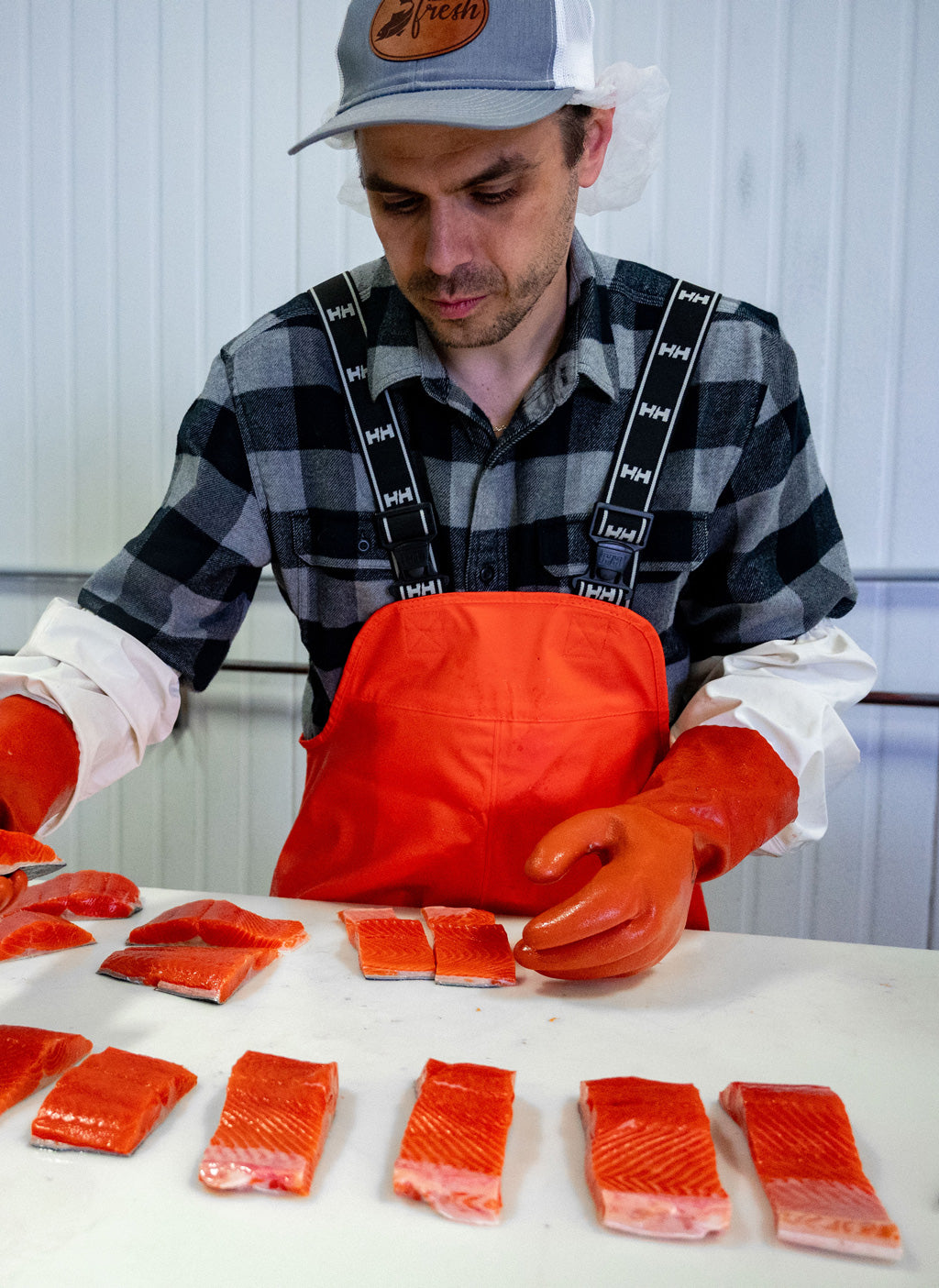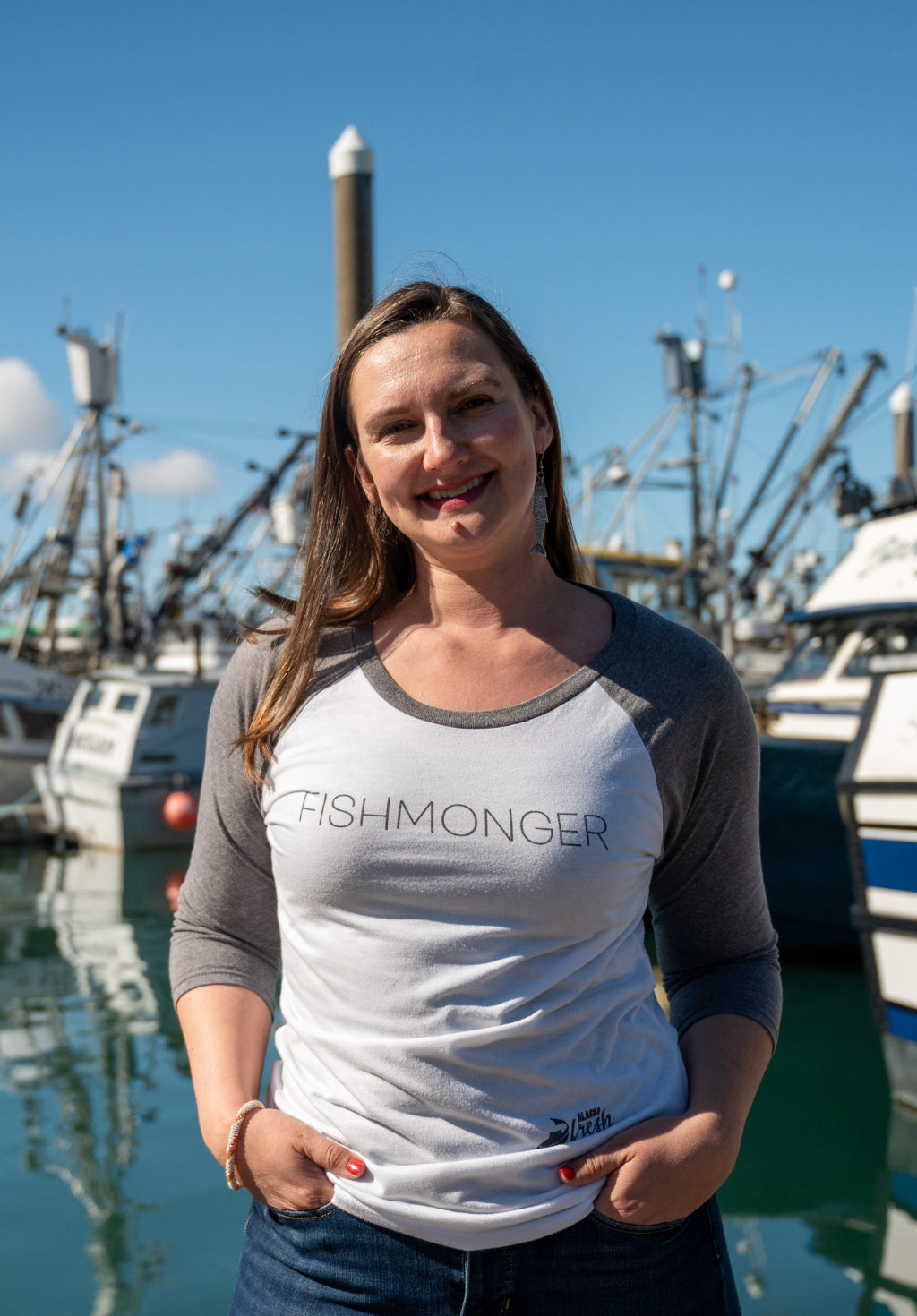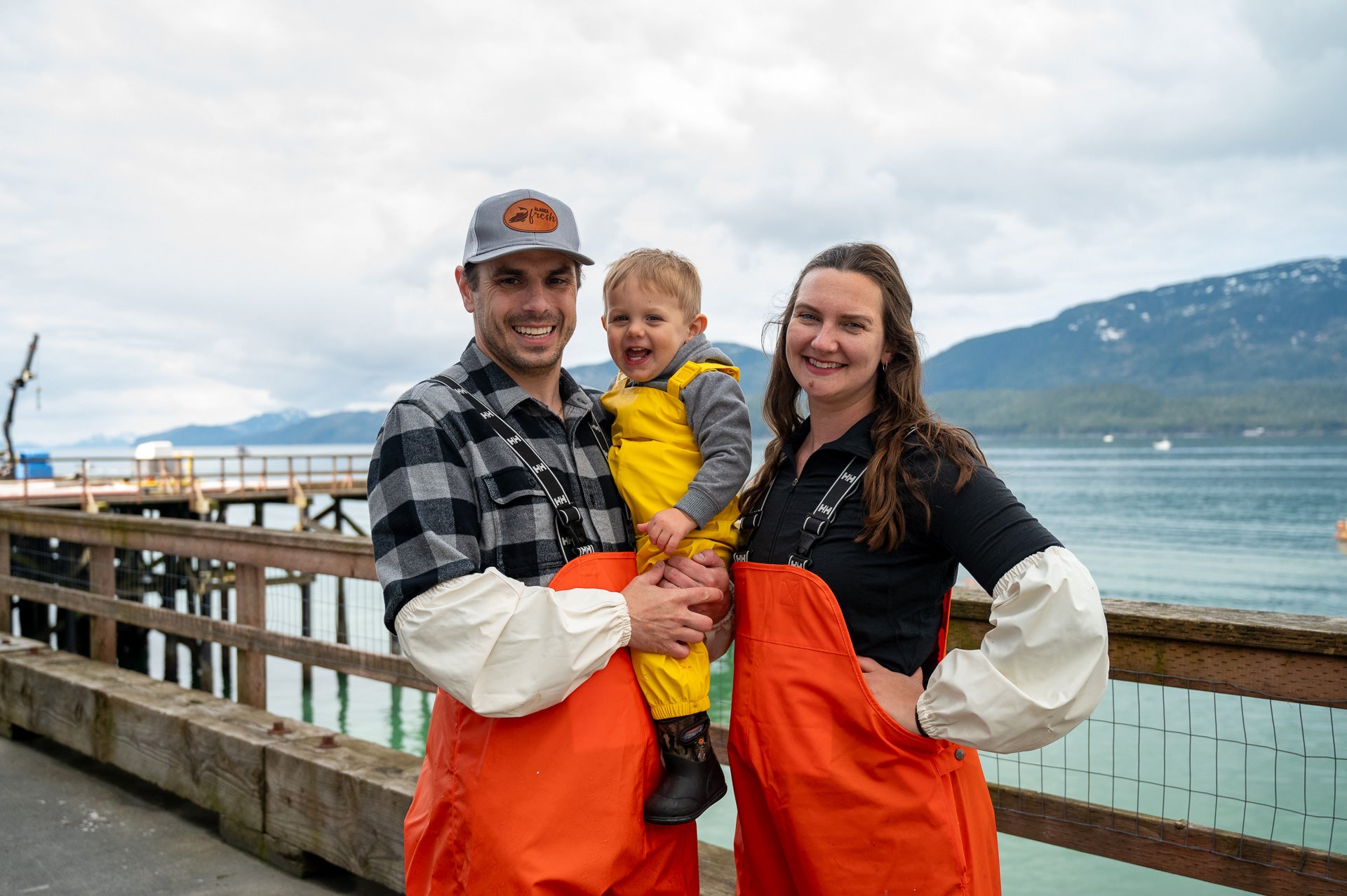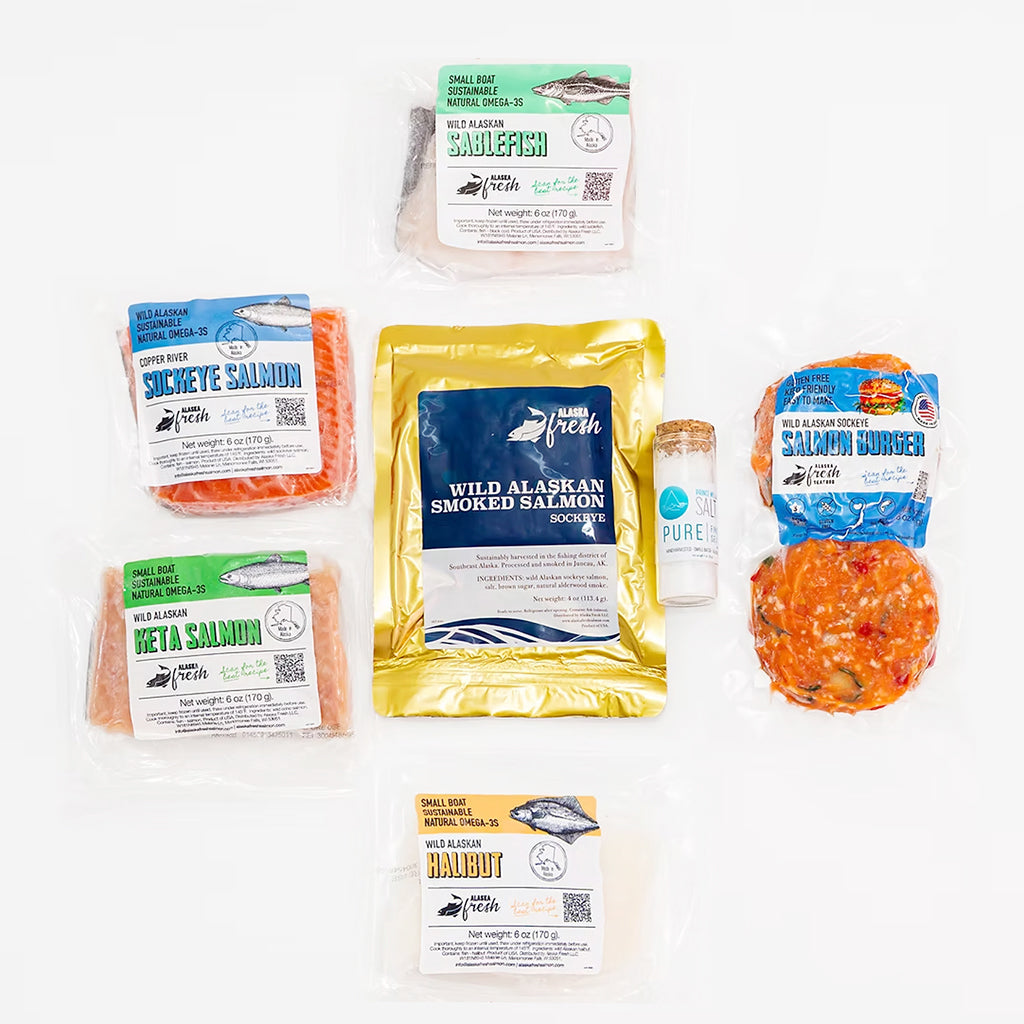
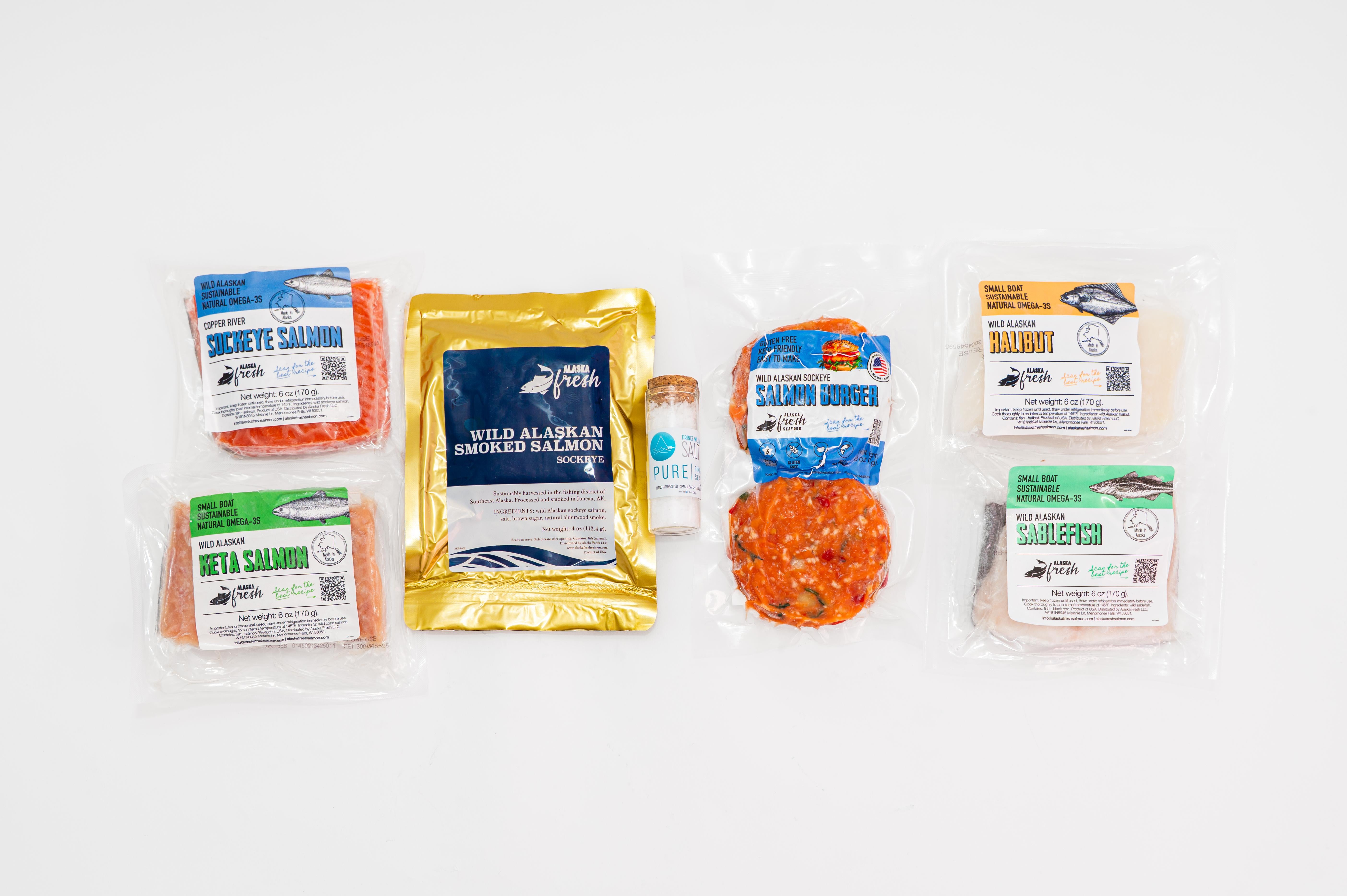
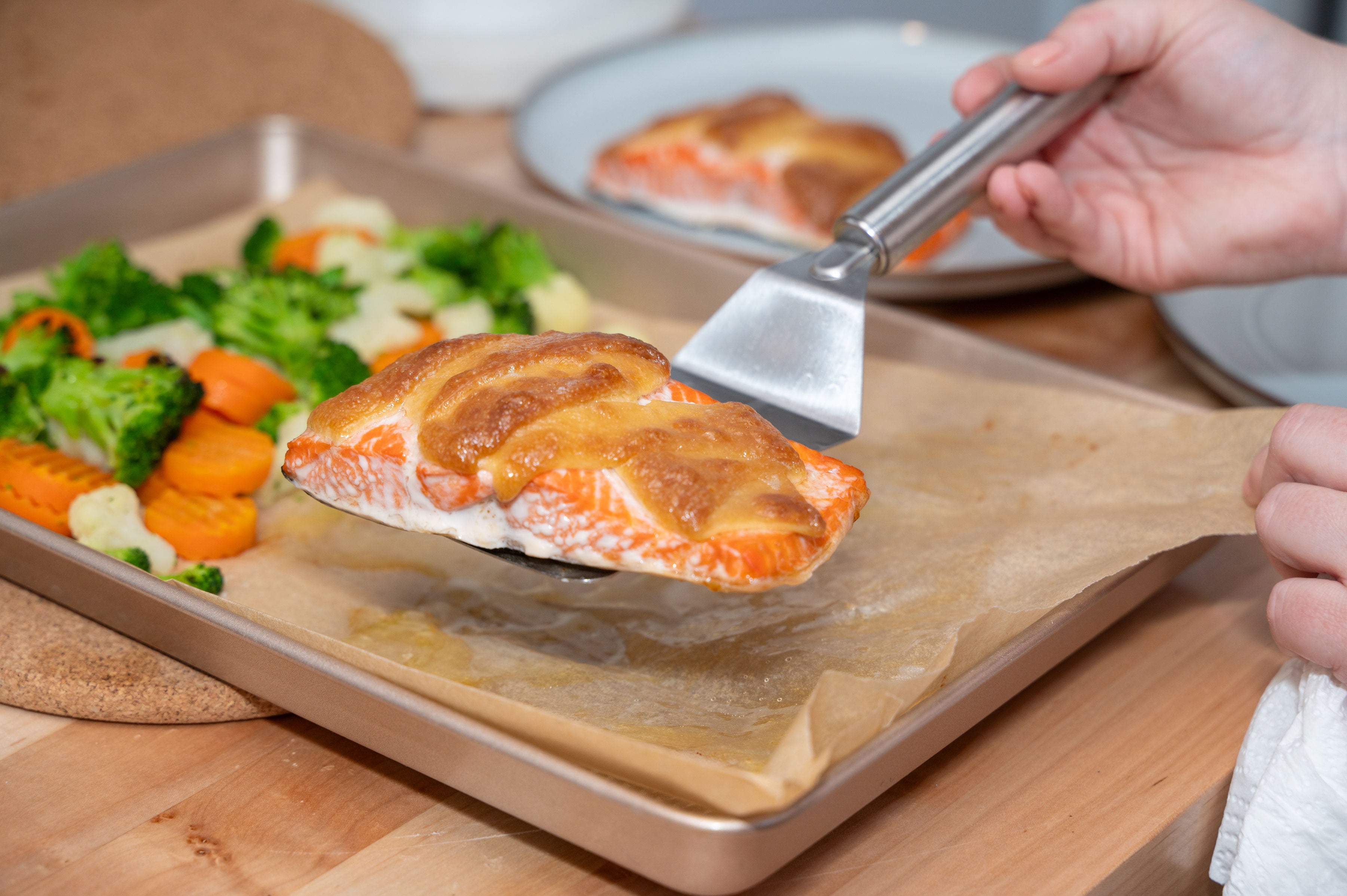
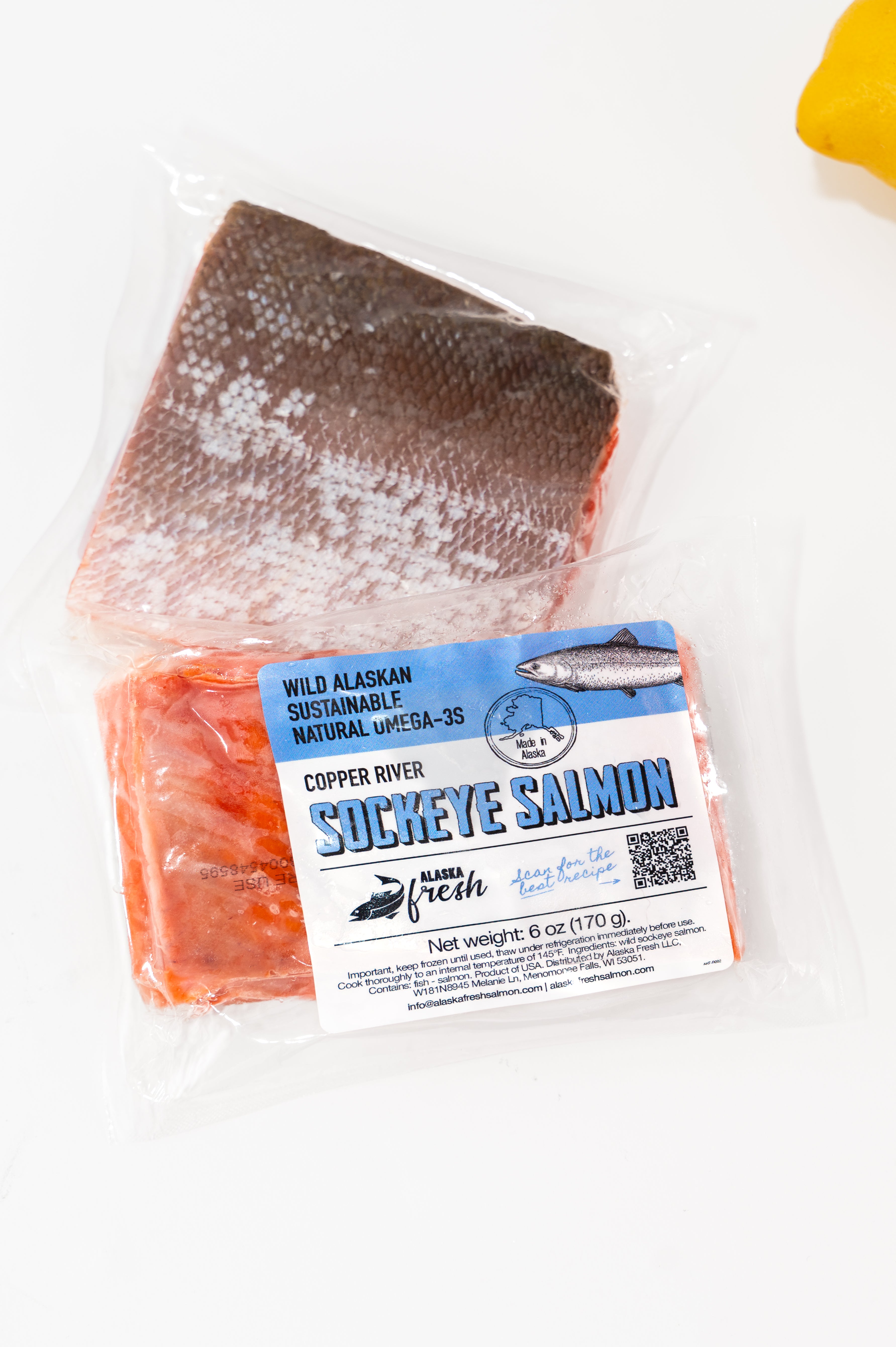
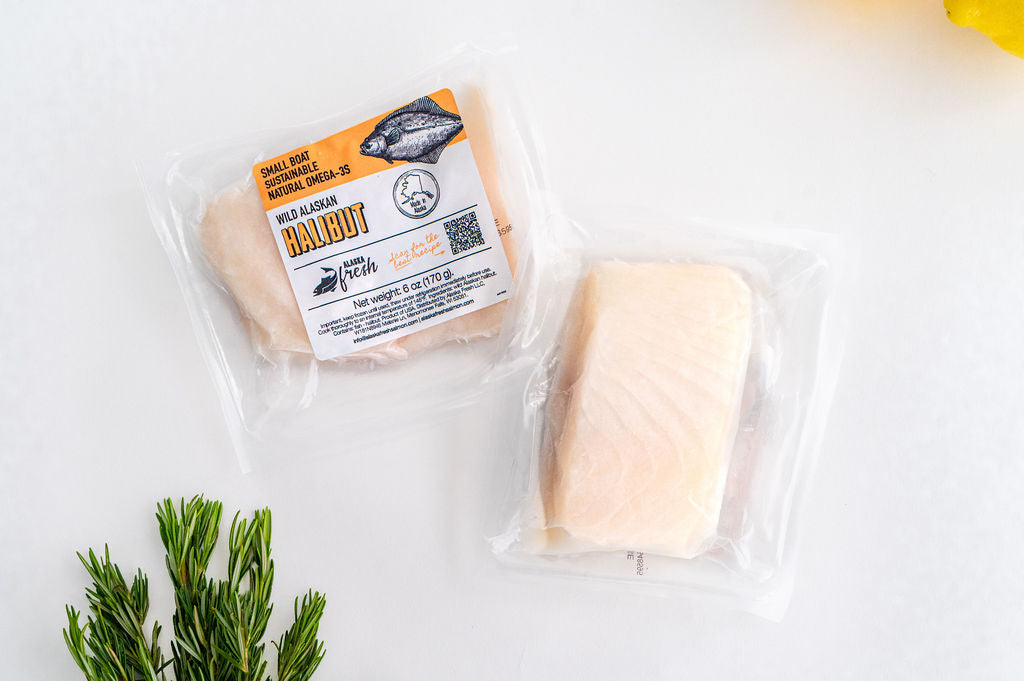

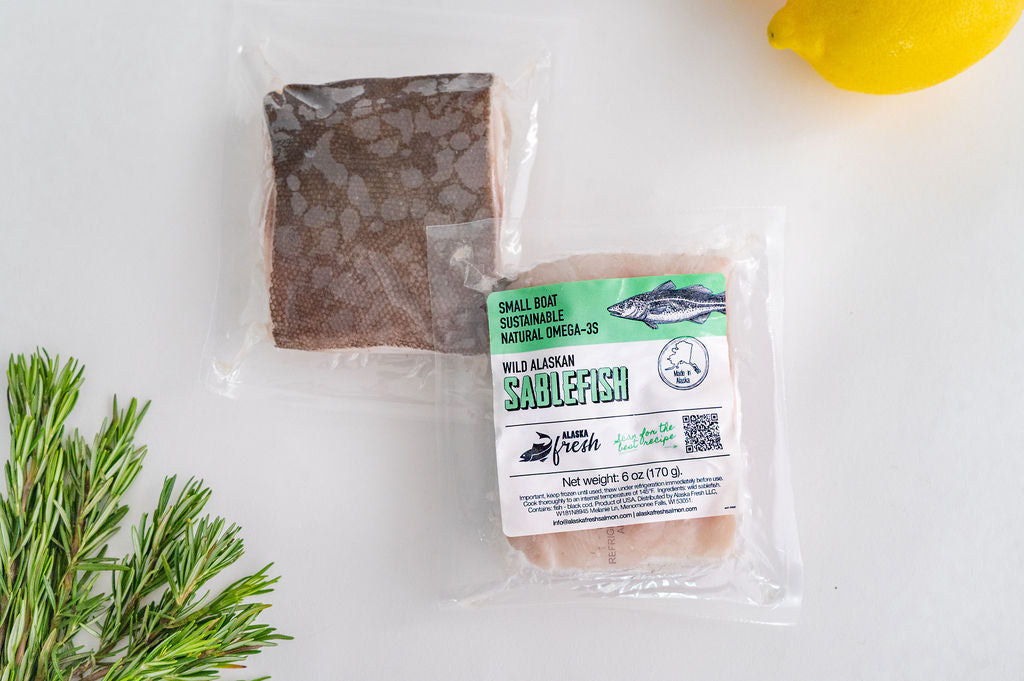
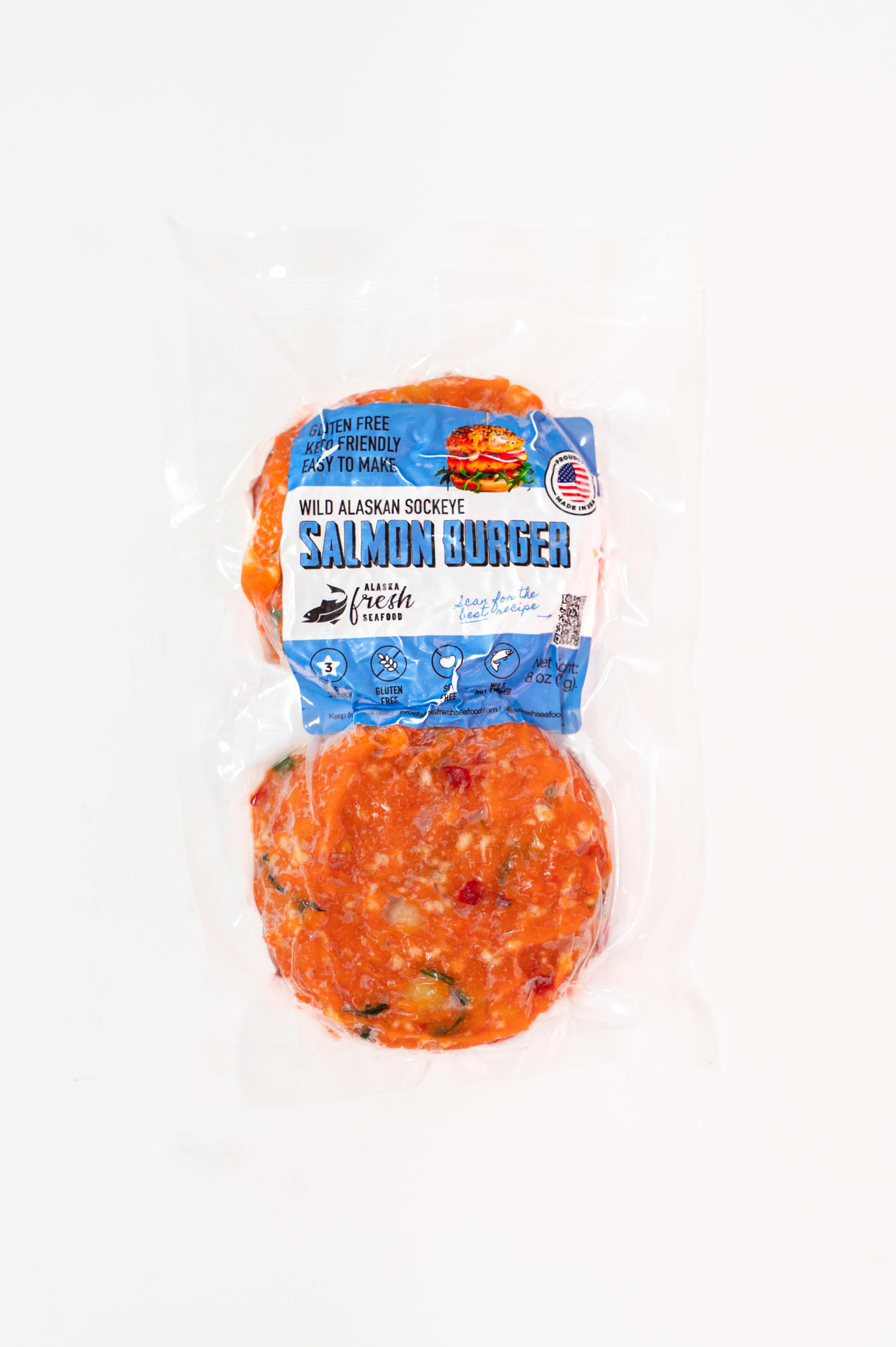
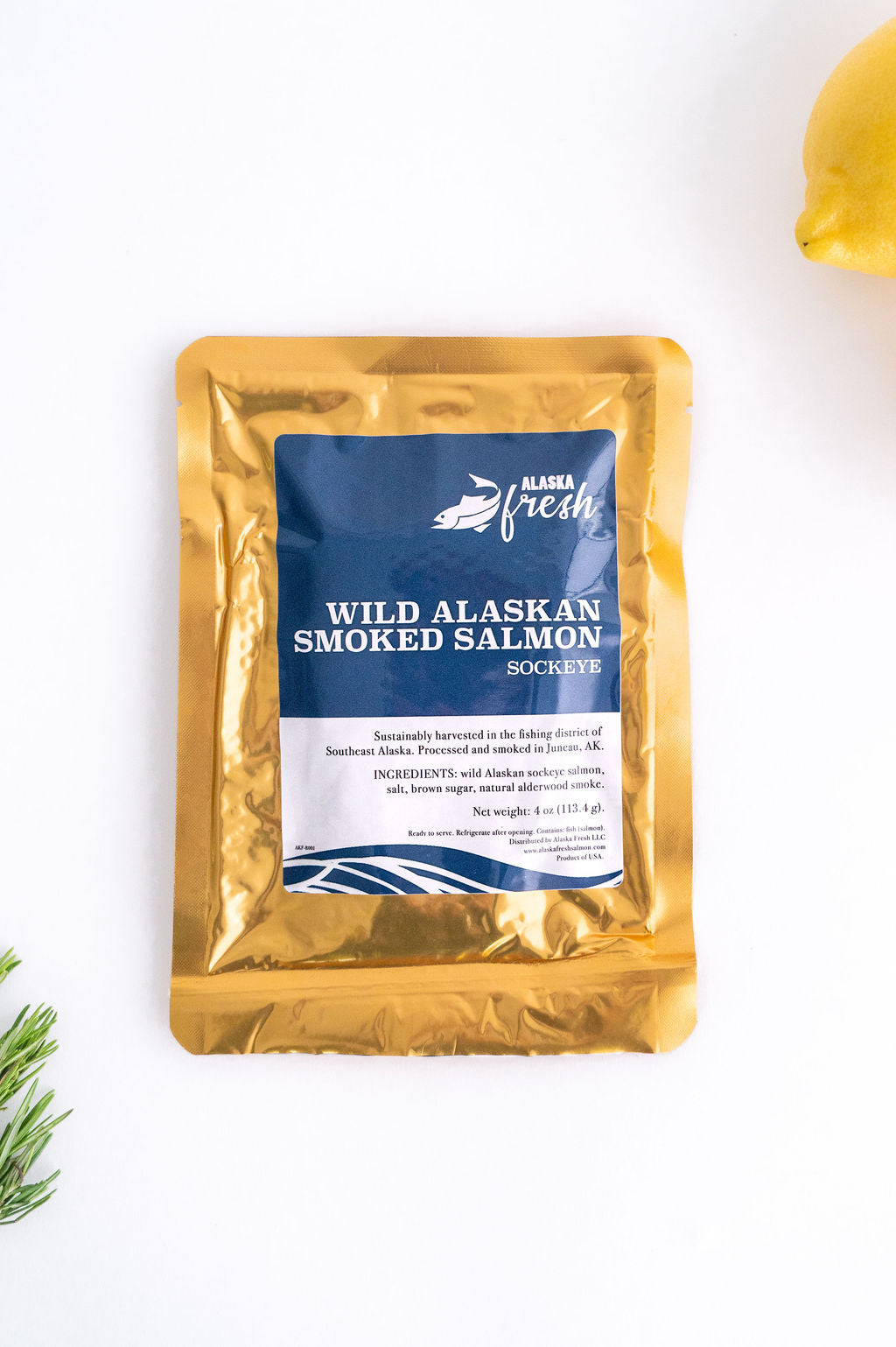

Alaska Sampler Box
The legend that made Copper River famous. Every spring, Copper River sockeye battle 300 miles of fierce glacial currents, building the rich fat, firm texture, and deep ruby-red color that made this the most famous salmon run in the world. This is the bold, clean-flavored Alaska salmon that chefs wait for all year, the one that turned "Copper River" into a mark of excellence.
Add a Gift Message
Make this gift extra special with a personalized message

Wild caught in Alaska

Flash-frozen at peak freshness

Most omega-3s in any salmon

Gluten free, keto and paleo friendly

Frozen guarantee
PACKED WITH GOODNESS
The most affordable way to be introduced to the world of wild Alaskan seafood - our Alaska Sampler Box.
This box is excellent for someone who would like to try Alaskan seafood but doesn't want to commit to large quantities or spend too much money.
It was built as an affordable gift idea, but won't disappoint as a sampler box if you just want to try something different yourself!
If you include a gift message at checkout, the box comes with a complimentary handwritten card with your personalized message.
This special box contains:
- Copper River Sockeye Salmon (6oz) - 1pc
- Wild Alaskan Halibut (6 oz) - 1 pc
- Wild Alaskan Keta Salmon (6oz) - 1 pc
- Wild Alaskan Black Cod / Sablefish (6oz) - 1 pc
- Sockeye Salmon Burgers - Wild Alaskan (8 oz) - 1 pc
- Wild Alaskan Smoked Sockeye Salmon Pouch (4oz) - 1 pc
- Prince William Sound Pure Flake Finishing Sea Salt (1/2 oz) - 1 pc
Copper River sockeye salmon is one of the most sought-after salmon in the world. It's known for its bright red color, bold flavor, and high levels of various nutrients, especially Omega-3s fatty acids that are a powerhouse for your heart and brain. It's also rich in proteins, vitamins, and a powerful antioxidant astaxanthin.
Wild Alaskan halibut is excellent for people who don't eat ocean products that often. The meat-like texture and delicate flavor make halibut an excellent "gateway" fish for anyone who is trying to find their way to eating more seafood.
Omega-3s are one of the main reasons people want to add seafood to their diet and wild Alaskan sablefish has more of them than almost any other fish! This underrated delicacy, also known as black cod, has flaky meat and smooth, buttery texture with a hint of sweetness that reminds you of crab legs.
Smoked Wild Alaskan Sockeye salmon pouch contains 4oz of cold smoked and pressure-cooked salmon that will show you the Alaskan way of smoking and preserving fish. The careful process preserves all the juices, flavors, and nutrients in the fish, while smoking and cooking make this product shelf-stable and ready to eat. The one-of-a-kind packaging makes this pouch an ideal travel companion, while the contents of the pouch can produce a world-class meal or be a healthy and nutritious snack by itself.
If you like to add a little flavor to your fish, our Prince William Sound Pure Flake Finishing Sea Salt is perfect for you. The salt was harvested by Alaskan commercial fishermen in the same area where your fish are caught. The local science center helped them develop the salt harvesting process, balancing the perfect salt content of the product and the environmental protection of the ocean.
OUR FISH SOURCE
Our fish are caught exclusively by small boat Alaskan fishermen in the Copper River and Prince William Sound fishing districts just outside of Cordova, Alaska.
The men and women in our fleet are dedicated to the best handling practices, such as bleeding every fish immediately after it comes out of the water, using slushed ice or refrigerated sea water to minimize the pressure on the meat and keeping their fishholds at 32 – 36 degrees Fahrenheit to maximize the shelf life of the product while they transport and deliver their catch to our processor.
SHIPPING INFORMATION
STANDARD SHIPPING:
Your order will ship via UPS the Monday, Tuesday or Wednesday after you place your order. Your fish will arrive Tuesday - Thursday depending on your location. The orders are shipped from our hub in Milwaukee with dry ice for transit. Don’t worry, ALL fish are from Alaska! We do quality control and reduce your shipping cost by shipping from Milwaukee.
EXPEDITED SHIPPING:
If you pick expedited shipping during checkout, your order will be shipped within one business day with overnight delivery. With the exception of our shelf stable products, we are not able to ship on Fridays.
PICK-UP:
You will receive an email when your order is ready with instructions on how to coordinate your pick-up date, time, and place.
FROZEN GUARANTEE
Frozen shipments are shipped with ample dry ice to sustain the shipment duration. Frozen products need to be put in the refrigerator for immediate consumption or in the freezer for future use shortly after delivery. The dry ice is sublimating during the shipping process so your shipment may arrive with no ice left in the box, but it is good and safe to consume as long as it remains frozen.
If your shipment arrives partially thawed on the edges, it is still good and safe to consume. If the frozen products arrive completely thawed out or damaged in any other way, please take pictures and/or videos with as many visual details as possible and contact us for a possible refund or reship.
WHAT IS INCLUDED
The Wild Difference You Can See, Taste & Feel
Good For You Naturally
Recommended recipe
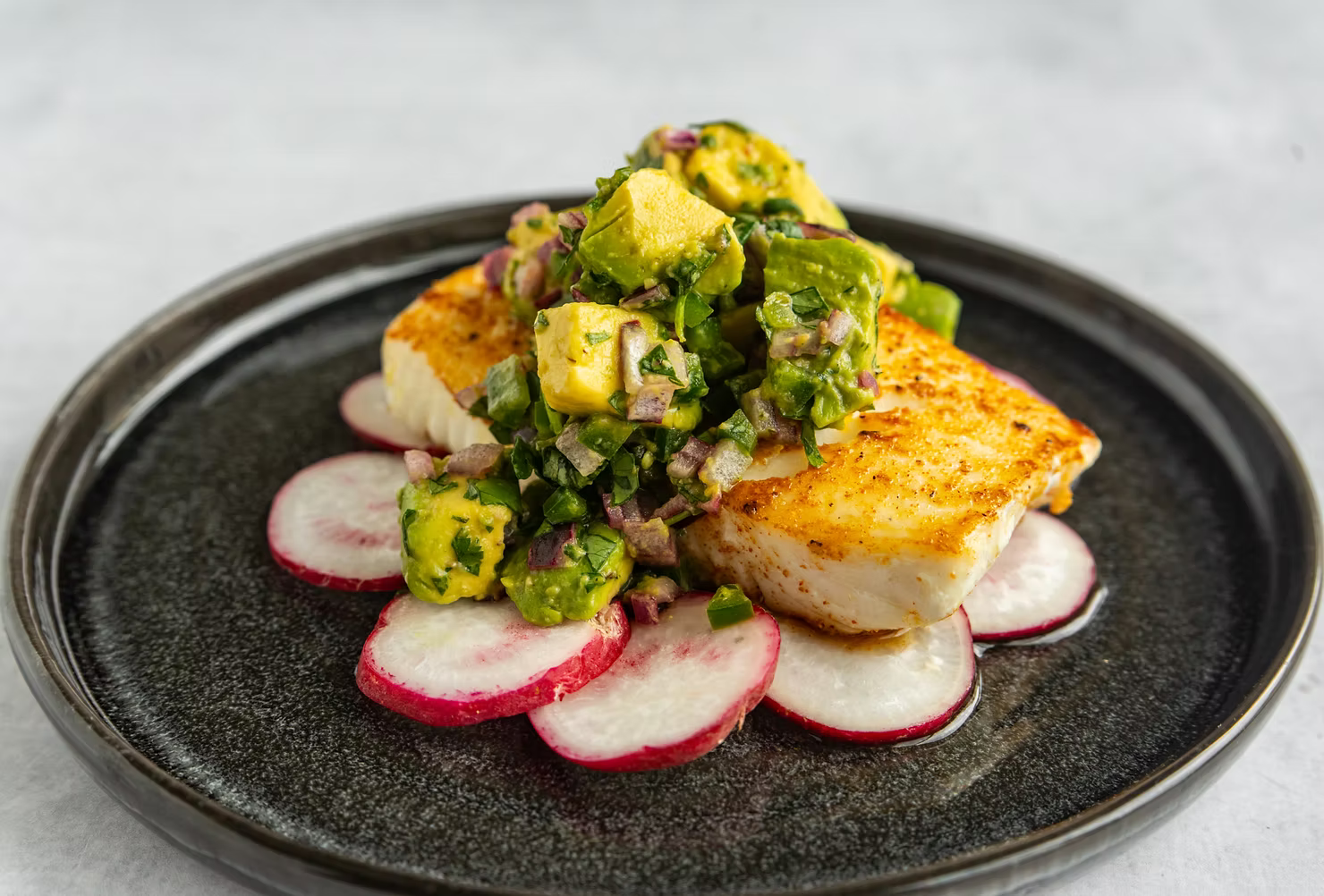
Pan Seared Halibut with Avocado Salsa
A bright, fresh, and flavorful dish perfect for summer—this seared halibut is topped with a creamy, zesty avocado salsa and finished with crisp sliced radish for the perfect bite.
Serves: 2
Ingredients
For the Halibut:
- 2 halibut fillets (about 6 oz each)
- 1 Tbsp olive oil
- 1/2 tsp salt
- 1/4 tsp black pepper
- 1/4 tsp garlic powder
- 1/4 tsp chili powder
For the Avocado-Jalapeño Salsa:
- 1 ripe avocado, cubed
- 1/2 jalapeño, finely diced (remove seeds for less heat)
- 1/4 small red onion, finely diced
- 1 Tbsp fresh cilantro, chopped
- Juice of 1 lime
- Salt & pepper, to taste
Garnish:
- 2–3 radishes, thinly sliced
Instructions
- Prep the Halibut: Pat the halibut fillets dry with a paper towel. Rub both sides with olive oil, then season with salt, pepper, garlic powder, and chili powder.
- Cook the Halibut: Heat a non-stick skillet over medium-high heat. Once hot, add the fillets. Sear for about 4 minutes per side, or until the fish is golden and flakes easily with a fork.
- Make the Salsa: While the fish is cooking, combine the diced avocado, jalapeño, red onion, and chopped cilantro in a small bowl. Squeeze in the lime juice and season with salt and pepper to taste. Gently stir to combine.
- Assemble & Serve: Plate the halibut and top generously with the avocado-jalapeño salsa. Garnish with fresh radish slices for a crisp finish.
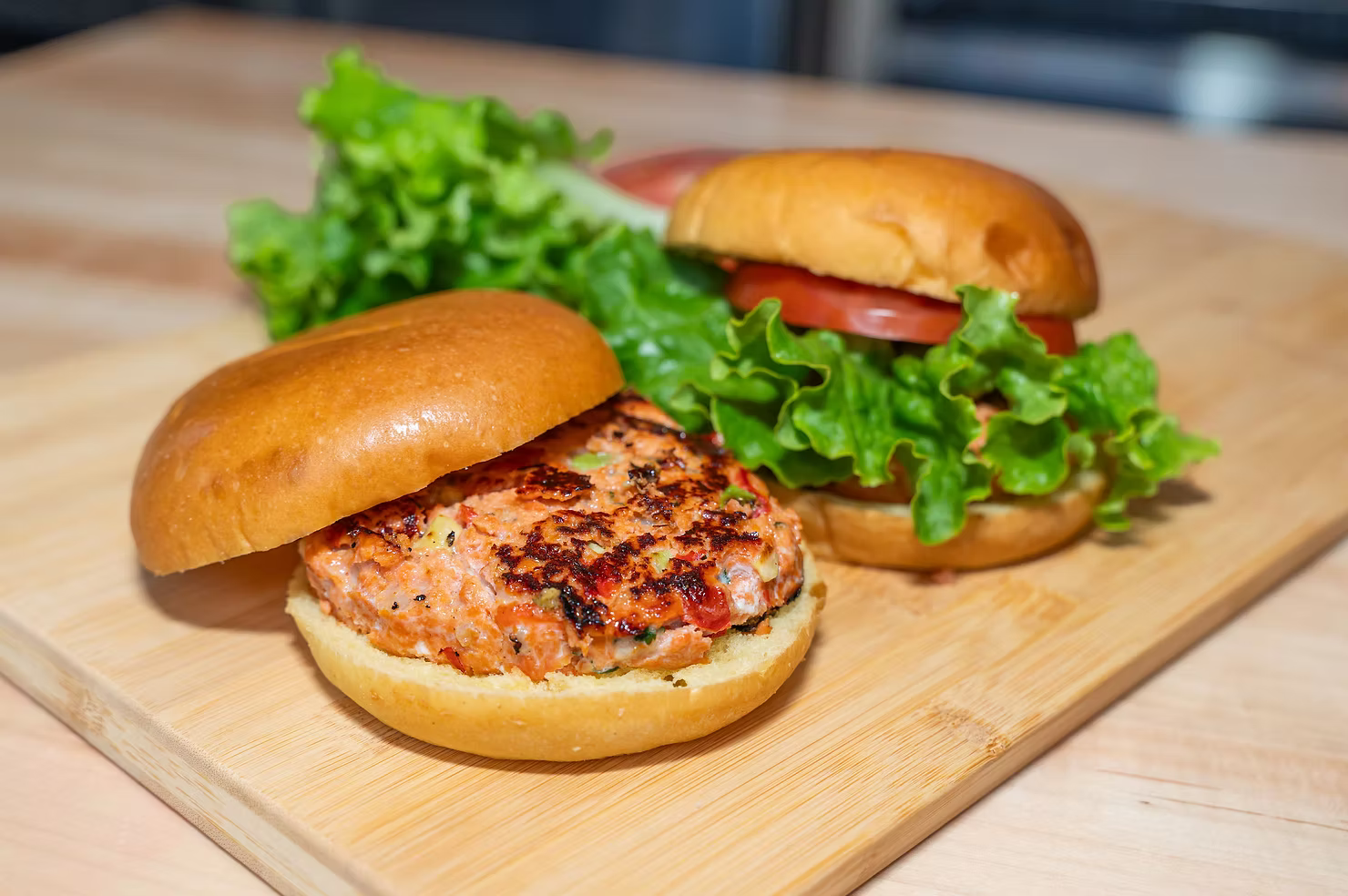
Wild Alaskan Sockeye Salmon Burgers
Salmon burgers are a sustainable alternative to classic red meat burgers, which have an extremely high carbon footprint due to livestock methane emissions.
Ingredients
For the Salmon Burgers:
4 premade salmon burger patties (Asian‐flavored, ~6 oz each)
4 burger buns (brioche or whole‐grain)
4 lettuce leaves (butter or romaine)
1 tomato, sliced
4 slices red onion (optional)
4 pickle slices (optional)
½ cup mayonnaise or Asian-style aioli (for spreading)
1 lemon, cut into wedges (for serving)
For the Frites (French Fries):
2 lbs russet potatoes, scrubbed and cut into ¼-inch sticks
3 cups beef tallow (for frying)
1 tsp sea salt (or to taste)
½ tsp black pepper
¼ tsp garlic powder (optional)
For Assembly & Garnish:
2 cups cooked rice (optional side)
1 tsp toasted sesame seeds (optional)
2 green onions, thinly sliced (optional)
Instructions
- Prep the Potatoes for Frites:
Rinse cut potato sticks under cold water until water runs clear.
Pat dry thoroughly with a clean kitchen towel or paper towels.
Spread in a single layer on a baking sheet; refrigerate (or rest at room temperature) for 15 minutes to remove excess moisture. - Cook the Frites (First Fry):
In a heavy-bottomed pot or deep fryer, heat beef tallow to 300 °F (150 °C). Use a thermometer.
Working in batches, add potato sticks (avoid overcrowding). Fry until they begin to soften and turn pale golden, about 4–5 minutes.
Remove with a slotted spoon; drain on a wire rack or paper towels. Let rest while you cook burgers. - Cook the Premade Salmon Burgers:
Remove frozen or refrigerated salmon patties and follow package instructions:
If frozen: Preheat oven to 400 °F (204 °C). Place patties on a parchment-lined baking sheet. Bake 10–12 minutes until internal temperature reaches 145 °F (63 °C), flipping halfway.
If thawed: Heat a nonstick skillet with 1 Tbsp avocado oil over medium heat. Cook patties 3–4 minutes per side until golden and cooked through (145 °F internal).
Transfer cooked patties to a plate; cover loosely with foil to keep warm. - Finish the Frites (Second Fry):
Increase tallow temperature to 375 °F (190 °C).
Fry par-cooked potatoes in batches until crisp and deep golden, about 2–3 minutes.
Remove with a slotted spoon; drain on paper towels or a wire rack. Immediately season with sea salt, black pepper, and garlic powder (if using). - Assemble the Salmon Burgers:
Lightly toast burger buns if desired.
Spread mayonnaise or Asian-style aioli on the bottom bun.
Place a lettuce leaf, one salmon patty, a tomato slice, red onion slice, and pickle (optional).
Squeeze a lemon wedge over the patty; close with top bun. - Serve:
Arrange each burger on a plate with a generous portion of hot frites.
If desired, sprinkle toasted sesame seeds and sliced green onions over the frites or burgers.
Serve with extra lemon wedges and your choice of dipping sauce (ketchup, aioli, or sriracha mayo).
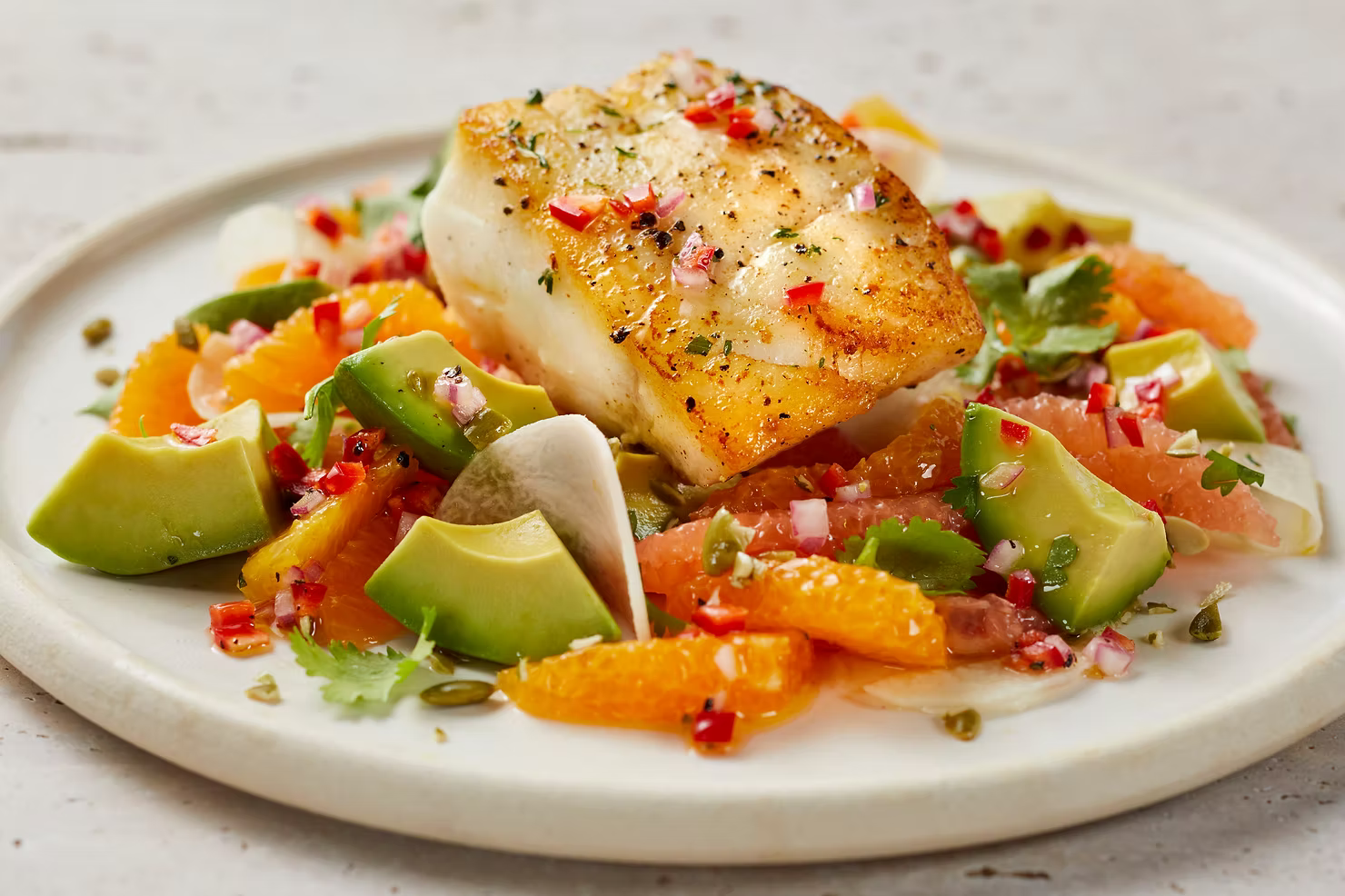
Wild Alaskan Black Cod (Sablefish) with Citrus, Avocado
Celebrate wild Alaskan sablefish's deep flavor with lemon, avocado, jicama, and Fresno chile vinaigrette. This delicious meal masterpiece perfectly blends Alaskan fish flavors and textures. Experience refined freshness with every bite.
Servings: 4
Ingredients
4 tbsp Fresno chile peppers stem removed, finely diced
2 tbsp red onion, fine dice
½ cup lemon juice, freshly squeezed
½ cup extra-virgin olive oil
1 tsp agave, light
1 tsp salt
4 wild Alaskan sablefish (black cod) fillet portions, salt & pepper on each
1 tbsp rice bran oil or 75/25 oil blend (75% canola/25% olive oil)
2 tbsp butter
1 garlic clove
3 thyme sprigs
1 small jicama, peeled
1 ruby red grapefruit
1 navel orange
1 cara cara or blood orange
2 avocados, sliced
¼ cup cilantro, washed, coarsely chopped
¼ cup toasted pepitas, unsalted, lightly chopped
Directions
Fresno Chile vinaigrette
• Add the diced Fresno and onion to a small mixing bowl with the lemon juice, olive oil, agave, and 1 tsp salt. Whisk to combine.
Pan seared Wild Alaskan sablefish (black cod)
1. Lay the wild Alaskan sablefish (black cod) fillets out on a cutting board, cut into 4 equal portions, and pat dry with paper towels. Season both sides with salt and pepper.
2. In a preheated pan on high heat, add oil and swirl to coat the bottom of the pan. When the oil starts to smoke, carefully add the wild Alaskan sablefish (black cod) portions to the pan. Cook for 3-4 minutes or until golden brown on the first side, then flip and continue cooking about 2-4 minutes more, depending on the thickness of the fillets. When the wild Alaskan sablefish (black cod) is just about cooked through, smash a garlic clove, and add it to the pan with the butter and the thyme sprigs. As the butter melts, tip the pan so the garlic and thyme infuse the butter, and baste the wild Alaskan sablefish (black cod) for 15-20 seconds.
3. Transfer the fish to a warm plate to rest.
4. For the citrus fruit, supreme the segments and discard the core.
5. Scoop the avocado out of its peel, and discard the pit. Lay the avocado out on a cutting board, and season with a squeeze of lemon juice, and a few pinches of salt. Cut into large chunks.
6. For the jicama, peel, then shave very thin on a mandolin. Stack up the jicama slices and cut to roughly 1" by ½" tiles. Toss 2 cups of cut jicama with ¼ cup of the vinaigrette and scatter across the center of 4 chilled plates.
To serve
1. Scatter a few chunks of each type of citrus over the jicama. Repeat with the avocado chunks, creating a colorful mosaic with the citrus.
2. Transfer one piece of cooked wild Alaskan sablefish (black cod) to each plate, stacking it atop the center of the mosaic. Drizzle the resting juices over the top of the wild Alaskan sablefish (black cod). Vigorously whisk or stir the vinaigrette, then drizzle 2 tablespoons over each plate, dressing the avocado and citrus, as well as the wild Alaskan sablefish (black cod). Sprinkle the chopped pepitas and chopped cilantro over the entire plate to garnish.
ASK YOUR FISHMONGER
What makes Copper River salmon special?
Copper River salmon have to swim 300 miles up the stream of an icy cold Copper River Watershed to get to their spawning grounds. They have to gather enough muscle and fat to survive this tremendous journey. The high fat content gives Copper River salmon its incredible taste, moist texture and a lot of Omega-3 acids, one of the most important nutrients in any fish.
This unique salmon is praised amongst the top chefs for its taste and texture qualities, while home cooks also enjoy the simplicity. Copper River salmon tastes so good that the only other ingredient you need is a little bit of salt.
High quality brings high demand, but whether you look for kings, sockeyes, or cohos, Copper River salmon is hard to get. Knowing its uniqueness and fragile balance in the ecosystem, everyone involved in the Copper River fishery works towards a sustainable future. Fishing season is short with areas and times regulated to guarantee the needed escapement for future populations to thrive year after year.
Fishermen are often considered lucky to be able to participate in the Copper River fishery and they are known to be a poster child of quality fish handling and temperature control.
When is Copper River salmon season? Is this from this year's catch?
Copper River king salmon has the shortest fishing season, usually from mid to late May until late June, early July. Copper River sockeyes can be caught from mid May until late July and cohos usually run from early August until late September.
Why is Copper River sockeye salmon more expensive than regular sockeye?
Copper River sockeye salmon is more expensive than regular sockeye because of where and how it’s harvested, and how it’s handled. Think of it as the “wagyu beef” of salmon. Copper River sockeye (same as Copper River coho and king) are specifically from the Copper River fishing district, in South Central Alaska, full of pristine, glacial-fed waters. The salmon swim free range for 3-7 years in the Pacific ocean to build up fat and muscle for their 300 mile journey against the strong and cold river current back to their spawning grounds in the Chugach mountains.
The fish are harvested by one person, on a small boat, each one picked from the net, by hand. There are no mass fishing boats allowed in the district. The fishery is a poster child for quality and sustainability, unlike many fisheries around the globe where fish stocks are drained.
The fishing fleet is less than 500 boats, all of which undergo specific training and protocols for how to properly handle each fish after catch with particular bleeding and slush-ice storage methods.
Fishing for Copper River salmon is an art form. The technique has not changed much over centuries, which is becoming more and more rare as working waterfronts collapse due to mismanagement - something you do not need to worry about when sourcing from the Copper River.
Why is the fish frozen?
Flash freezing fish right after catch is the only way to preserve its quality. Fish in general have very short shelf life and they start to spoil right out of the water. Bringing fish from Alaska without freezing can negatively affect the appearance, structure and taste.
It's a seasonal fish so you need to stock up in the summer to enjoy it year-round. We freeze our fish at peak freshness, as soon after the catch as possible, so when you thaw them out before cooking, they taste as fresh as they were when they came out of the ocean.
What's the best way to cook halibut without it falling apart?
Halibut is not like haddock or walleye and does not fall apart when cooking. It is a very steaky fish and maintains it’s structure when grilling, baking, pan-searing or air frying. Because our fish is sushi-grade, we always recommend to cook it for less time than you think, so as not to dry it out. Fish also continues to cook once it's removed from the heat source.
Does halibut taste 'fishy'?
We like to say that “halibut is the white fish that ruins every other white fish” because it is so darn good. It literally does not taste like fish. It is super “steaky” and mild in flavor which makes it a popular choice on restaurant menus.
I've never heard of sablefish. What is it?
Sablefish is also called Black Cod or Pacific Butterfish. It is a super healthy fish with a buttery texture and sweet flavor. It has more omega-3 fatty acids than Copper River king salmon! It may be the most underrated wild Alaskan fish on the market.
Majority of the Alaskan sablefish catch gets exported (mostly to Japan), but in recent years it has been steadily gaining popularity in the US.
What does sablefish taste like?
Imagine a super fresh high end cod that’s cooked in a lot of butter. Silky and buttery, with a very recognizable sweet taste. All you need is salt and pepper and sablefish, or black cod as a lot of people call it, will not disappoint.
How do I cook sablefish?
Like our salmon and halibut, you can just add salt and pepper and bake, pan-sear, fry, grill or air-fry and you will end up with a fantastic meal comparable to a high end restaurant. We’ll give you instructions for each cooking method with your order. Also check out this popular post - Top 5 Best Sauces for Sablefish.
Meet your Fishmongers
With 17+ years living in Cordova, Alaska, owners Adra and Juro built relationships directly with local fishermen and ran seafood processing operations, giving us the inside perspective most seafood companies simply don't have.
We hand-pick each fish from trusted boats, then partner with elite processor Copper River Seafoods (where Juro worked for 13 years) to ensure every fillet is perfectly cut, flash-frozen within hours, and vacuum-sealed to lock in peak freshness for up to two years.
While there's a myth that "never frozen" is best, the truth is unless you live on the Alaska coast, our flash-frozen fillets will taste fresher than anything that's been shipped fresh for days. We guarantee that our proven boat-to-box process delivers the quality consistency you deserve, with the personal expertise you can trust.

